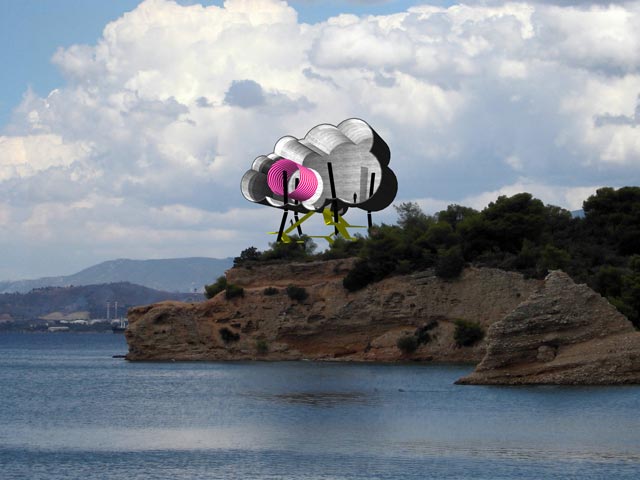This interview accompanies the presentation of Neen as a part of the online exhibition Net Art Anthology, and is part of a series of interviews with Neen participants. Other interviewees are Mai Ueda, Andreas Angelidakis, and Rafaël Rozendaal. Domenico Quaranta also contributed an essay on Neen in the context of net art.
Aria Dean: How were you introduced to Neen and how did you understand it conceptually at first?
Nikola Tosic: In 1999 I was in Belgrade during the NATO bombing. I was a huge fan of Stanley Kubrick movies, and during the bombing I had a lot of free time, so I bought Kubrick.org and invited some fifty digital artists to recreate scenes from Kubrick films into websites. This was one of my first online artworks. One of the artists was Vitaly Leokumovich who was at the time based in New York City. In 2000 I moved to Milan and organized Meet in a nice restaurant, an event which consisted of series of dinners between digital artists, designers, entrepreneurs. Some fifty people showed up for Milan dinners, including Vitaly. Vitaly recommended the event to Miltos Manetas. Miltos could not make it but we met separately in Milan. I showed Miltos my artwork Lonliness.org and other Flash animations, and he loved them. He explained what Neen is and said I am part of it. Soon after I started meeting other Neen artists Miltos befriended—Mike Calvert, Mai Ueda, Steven Schkolne, Joel Fox, Angelo Plessas, Andreas Angelidakis, Rafaël Rozendaal.
I was familiar with net.art and already knew few net.artists like Vuk Ćosić and Hans Bernhard (etoy). The style did not suit me as it seemed very socially and politically oriented. I considered my art personal and independent of political and social issues. I understood Neen was the same. Neen communicated on the individual level. And most of it focused on positive feelings and connection through being positive. It was about jokes, puns, colors. I believed this was much closer to me and felt I can be part of it. It was the opposite of most other digital art which was much heavier and somewhat negative in my view. Everybody I met in Neen was relaxed, carefree, happy, and easygoing. Even Angelo’s work which is maybe the “darkest” makes the dark emotions happy and playful, which is why I might love it the most.
AD: What was Neen’s understanding of how people interact with computers/internet, and what they want from art?
NT: Neen, actually its artists, saw internet and computers same as everybody else did—as the best way to communicate. It was not necessarily the only medium, but it was the main medium to be present. Everybody painted, wrote, and did other things, but it somehow did not make much sense if it did not become a website or some kind of an online experience.
I believe Neen artists wanted to meet others like them. Neen was not a dominant style, but always a bit of a strange thing on the side, and we were a bit lonely. So it was great whenever we would meet someone else who would share the same ideas. Miltos was great at selecting people and defining the style, but he was always very bad with formal definitions. His definitions which focus on digital medium are not correct. Neen was about the positive feeling it creates, and not about the technology it uses. When I think of need I think of Calvert’s strawberries, Rafaël’s pull my finger, Andreas’s virtual cloud house, and Angelo’s fit woman. These are art I can share with my kids and they will love it and remember it instantly, while it is questionable if my kids would ever understand net.art of the same period. Neen is closest to Klee, Mondrian, and Calder maybe.

Andreas Angelidakis’s Cloud house.
AD: What form did Neen work take?
NT: At first there were a lot of Flash animations. Andreas made virtual environments. Mai Ueda was the first to write domain poems, and I continued it and focused only on writing, stopping to work on animations. There were events, performances, shows, films. But as I wrote, somehow all media had to use web as a main point.
AD: Is Neen as a word or a concept still useful? Where, if anywhere, do you see Neen's legacy in art and culture at large?
NT: I think the time for Neen passed because it was badly formalized by Miltos. Miltos had a great vision and taste, but he was never good at explaining it. His choice of artists and artworks was amazing and revolutionary, both in Neen and in his previous and later projects, but he was never able to make it last and make it into a mainstream. Neen has formally existed and has finished probably sometime around 2010.
I see its legacy as very important. Net.art is great, but it is only a single narrow point of view. Neen is also a single narrow point of view, but together they compliment each other. Internet art is richer because of each of them separately, but even more with both of them together.
Also all Neen artists continue to produce. Rafaël’s and Angelo’s work is amazing. I hope that, in twenty years, I will visit their shows with my kids and enjoy their art. I see myself as a poet and as I understood poets should not be relevant when young or even alive, so maybe my work becomes relevant one day. There are new artists which are influenced by Neen like Austin Lee, whether they know it or not, because they know Rafael’s and Angelo’s work.
My point is that Neen has finished formally but the concept continues to grow. Neen name is dead, but not the art.
Header image: Superneen, 2006.


